For a sailor accustomed to bareboat chartering in the Caribbean your first Mediterranean charter can be a big step. I’m here to tell you that it’s absolutely a step worth taking and with proper planning and preparation your first Mediterranean bareboat charter will be the best vacation ever! Don’t take my word for it; here’s what some of our crew had to say:
“I had a fabulous very unique vacation that I refer to as the trip of a lifetime.”
“It’s a great way to spend a vacation and I love sailing.”
“Best vacation ever!”
“It was the best vacation of my life”
“I didn’t grow up around sailing or ever wanting to sail; but after this trip, I think I could spend my life sailing and living on a boat.”
We’re using Greece, specifically the Cyclades, at the peak of the high season during the windiest month as the proving ground for our best vacation ever assertion. This is certainly boss mode and you can easily ratchet down the difficulty by choosing a less windy time of year, the area’s shoulder season or a different sailing area in the Mediterranean. There are plenty of other (all?) parts of the Mediterranean with calmer summer weather and very little chance of Gale force winds.
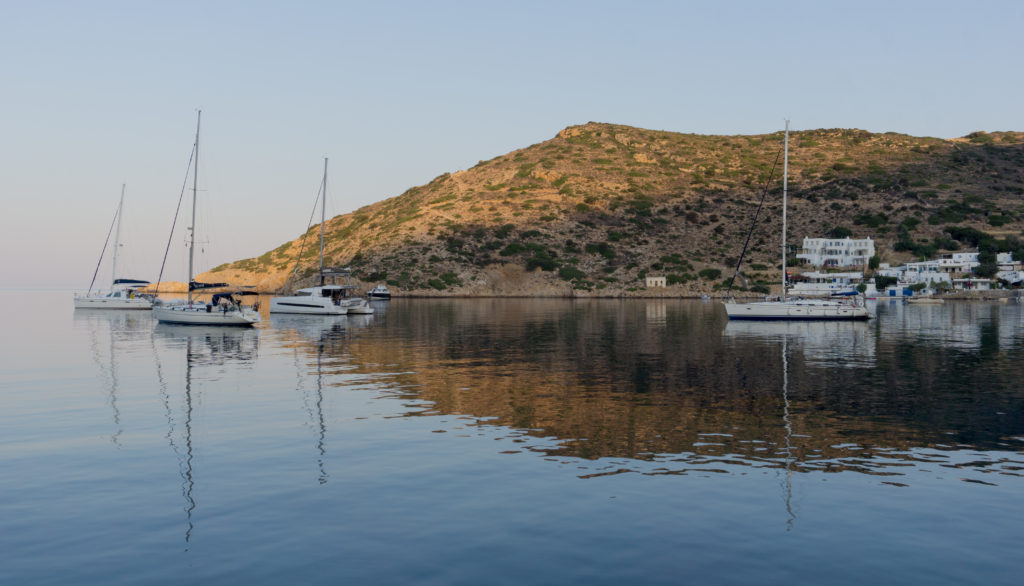
The underlying difference between Greece and the Caribbean is in the Caribbean the islands go out of their way to accommodate (and make money off) sailors; especially charterers. In Greece the marine industry has a “you’ll figure it out and you probably won’t die” mentality; this is true in other parts of the Med but they turn it up a notch in Greece. My most poignant personal example is at all of my other bareboat charters the charter company wanted their employees to move the boats within the base as they tend to pack the boats in. In Greece a charter company dock worker wandered onto our boat, confirmed I was the skipper and told me they were rearranging the boats so I needed to take my boat out and bring it back somewhere else. It wasn’t a big deal for me but it was the most crowded and chaotic charter dock I had ever encountered and 2 years ago I doubt I would have fared as well.
Credentials
In Greece, sailors from the USA need an International Proficiency Certificate (IPC). This article discusses how to obtain the IPC so I’ll not go into detail here.
When to Charter: Peak or off Peak?
To really be able to enjoy swimming and snorkeling along with sailing we knew we’d have to go sometime between June and September. But the real choice was between “peak season” (July or August) and “shoulder season” (June or September). The weather in July and August in the Cyclades is pretty much the same: July has slightly longer days (14.5 hours), July is a bit dryer (precipitation and humidity wise) while August has warmer water; these are small differences. June and September are also rather interchangeable weather wise: they have similar wind and temperature with June being a bit dryer and September has warmer water temperatures. Let’s simplify and use July as “Peak” and September as “Off-Peak”.
Looking at the climate data for Paros, right in the middle of the Cyclades, it was clear that July was the best weather for sailing and enjoying the waters around the Greek islands. July is the windiest month (though it does have the potential to be uncomfortably windy). July and August have the most dependable wind directions. July has the best beach weather: the least cloud cover, warm enough water and the least chance of rain.
We were looking for the quintessential Mediterranean charter with the weather that allowed swimming to be one of our main activities. We voted unanimously for July. We chose dryer and windier July over August but, as I mentioned before, they’re basically interchangeable.
Why not July? Why avoid the high season?
We also became aware that July and August were the busiest months of the year for tourism in the Cyclades. June and September were the shoulder season for tourism as well as beautiful beach weather (shocker!). We decided against the shoulder season because of the better weather in July and August. We weren’t that worried about crowds because having boats gives us options: we can stay at a busy marina near a town, can anchor in a secluded cove or something in between.
The other reason to avoid the peak season is the threat of strong North winds whipping through the islands for several days in a row; these winds are known as the Meltemi. Normally the Meltemi make for good sailing winds: the day gets windier until the late afternoon and then dies down after sunset. The winds become a problem when they last for several days at a time kicking up larger seas and strong currents.
Where From? More Meltemi Sailing or Questionable Charter Boats?
This is the first commitment you have to make is where and when to pick up your boats. If you’re game for longer sailing days you can opt to start from the multitude of bases on the mainland near Lavrio or Zea.
If you want to have shorter sails and spend more time exploring the Cyclades there are three charter companies (Dream Yacht Charters, Kiriacoulis and Istion) that allow you to charter boats out of the small “marina” in Parika, Paros.
You might think the competitive pressure of three charter companies in one port would improve service. But all three of these satellite locations are actually run by the same folks: Afros Yacht Services. We chartered from Dream and Kiriacoulis and checked in on the same rooftop, at the same desk with the same young woman and with the same last minute fees added on. I liked the guys I interacted with at Afros Yacht services but we had a lot of boat issues. Including:
- The water hose provided didn’t work on any of the dock’s nozzles that we saw the entire trip
- The anchor roller had been broken and re-assembled in the past and it had been re-assembled and welded together incorrectly – the guys at Afros yacht services helped me diagnose this problem but there was nothing they could do to remedy it before we left
- There was no jib on my boat until 7pm because it had been shredded by the prior guests
- The cleaning company didn’t properly close the hatch above the nav table before hosing down the boat and all of the paperwork and circuit breakers were soaked
- The engine bilge was full of water
- The furling line for the new jib was too small for the locking cam block that was supposed to secure it
We moved the furling line to one of the stern cleats to keep the jib partially furled while sailing. The undersized jib furling line actually managed to damage the block that was supposed to secure it – probably when the jib suddenly unfurled as we were sailing. They charged us 50 Euros for that block; it felt a bit like their job was to find something to charge us 50 euros for at the end of our charter and that was our thing; once they found it they stopped looking at the boat very closely though that could have also been because I showed them our solution to the most dangerous problem.
The source of the water in the engine bilge proved to be the biggest problem with my boat. It was coming from the exhaust hose on the cockpit manual bilge pump: the hose lock at the bilge pump had been damaged so the exhaust hose was lying in the aftmost part of the bilge. When we were sailing hard with the boat heeled over the 2” through hull the hose was connected to was underwater and seawater was coming aboard in buckets. The electric bilge pump was keeping up during our first day of sailing but since we were heeled over there was still a lot of water in other sections of the bilge. I discovered the source of the water after our first day of sailing and jury rigged the attachment of the hose to the manual bilge pump – the repair not only kept the water out but it also repaired the manual bilge pump which we then used to dry the bilge further. Still, water was working it’s way out of different hiding spaces into the main bilge for the remainder of the week prompting me to check the repair daily.
Accountability: Using a Charter Agent or Going it alone
We used an agent this time around. My hope was that we’d be directed to the better charter companies and boats. We also hoped that the charter agent gave us recourse because the agent could stop referring as many customers to the charter company if the charter company wasn’t good. Knowing that there were competing companies in Parika made this even more likely because the agent had options.
As I mentioned above there really weren’t competing charter companies in Parika so that collective buying power couldn’t really buy one better service. Still, I think the guys at Afros did a good job and after talking to other bareboat charterers that I met on the docks the skill and knowledge of the Afros guys seemed to be about as good as it gets on the islands.
Where To?
We decided to pick up the boats in Paros because it was pretty much in the middle of the Cyclades with boats to charter and an airport to fly into. Leaving from Paros it became easy to determine where we shouldn’t go.
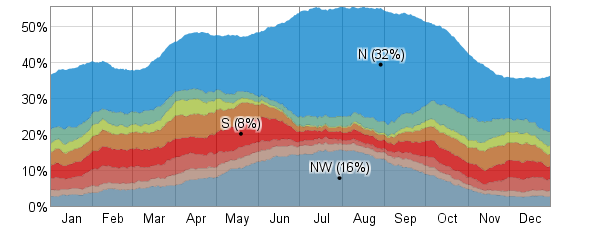
The main conditions we needed to worry about were a multi-day Meltemi. Not chancing a long passage across “Meltemi Alley” in big wind and seas meant we’d need to avoid going further east than Naxos. The pilot charts disagreed a bit with what we saw on land based climate information but we could be reasonably sure most of the wind would be from the North or Northwest.
Stated again for emphasis: the Meltemi is no joke. We were in the Cyclades ashore the week before our charter and it was blowing 30-40 for several days. The charter guests during that week shredded the jib on our boat. The charter boat next to us in the marina shredded both their main and jib and snapped the lower starboard spreader. The charter company employees were unfazed and had (poorly sized) replacement sails standing by; this was just another Saturday for them. If your skipper hasn’t been out in sustained 30+ I’d consider another charter location.
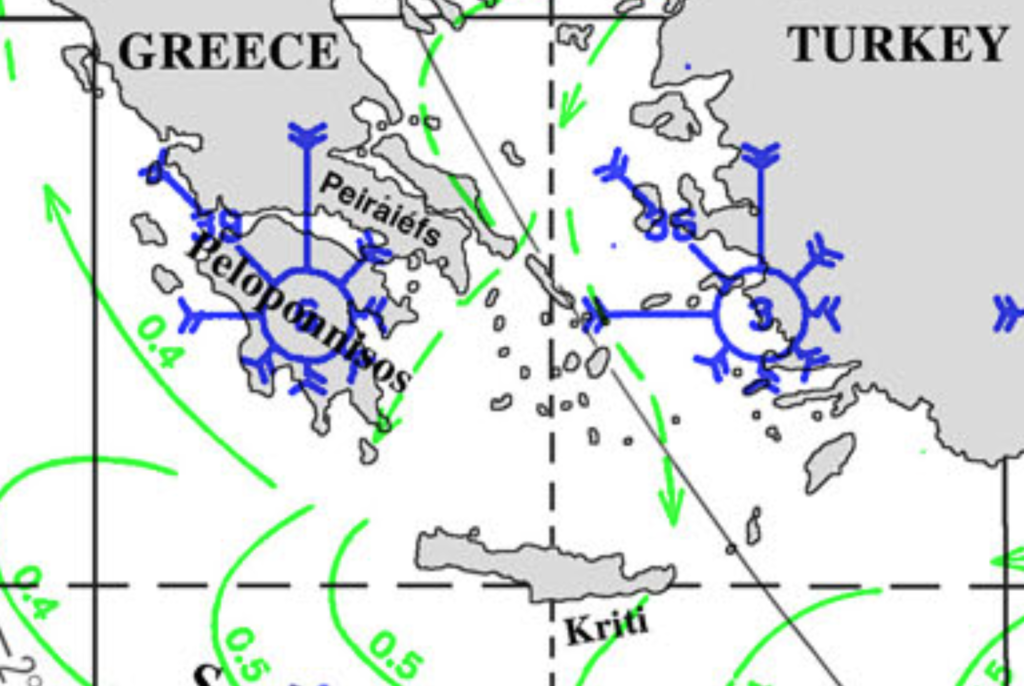
Prevailing northerlies and the best chance of strong winds being the Meltemi out of the north meant we’d also try not to get too far south during our charter; this way we avoid the chance of beating into a Meltemi to get back to the charter base in time. That means, for the most part, we want to head West or North from Paros at the beginning of the week and then make our way back more slowly. To the dismay of our crew this ruled out sailing 50nm south to Santorini.
A corollary of the prevailing strong northerlies is that if conditions favored making miles to the North we ought to put those in the bank. So for the first half of the week we’ll head north if we can and West if we can’t.
West Route: 94nm
The first itinerary proposed was 94nm (longest leg 35nm). It will be tougher if the wind is more out of the west.
North Route: 77nm
The North Loop is even shorter at 77nm with a 24nm longest leg but is only viable if we don’t have strong northerlies the first day.
Northwest Route: 114nm
The last route proposed was a 114nm loop that connects the two options. It was the longest route but the longest day is 30nm.
Where we went
Saturday: Parikia
Our check-in was arduous as you can read above. One tip for crew arriving in Parikia is that there are two very affordable bag check establishments right near the ferry terminal. If your crew arrive early they’ll really appreciate being able to drop their gear off and explore the town while the skipper and mate dry out the charts and drain the bilges and try to figure out why the anchor roller is weird and…
Sunday: Parikia, Paros to Pirgonisi Beach, Kimolos

If you look at our proposed routes above…
The first day was our longest sail. The forecast was calling for good sailing wind out of the north and then light winds the next two days so we wanted to make tracks on day one. After a brief upwind stint we cracked off to a broad reach for most of the sail. The winds were around 20 knots in open water so after a conservative start we rolled out all the sails and were making really good time.
The seas we’re on the starboard quarter so it was rolly and the crew weren’t feeling that well. And in the compression zone near Sifnos building to 30 knots combined with the seas rolling the boat had us going through the drill off reefing and then shaking out after getting overpowered.
We found a secluded anchorage with the wind blowing off the beach. Rather, it was secluded for most of the day but as sunset approached the population more than doubled from our 3 boats to 8. Still, at the end of the trip this was my boats least crowded overnight.
I kept busy repairing the boat while the crew weren’t ashore. They reported back that the town wasn’t much of a town and we spent the rest of the day hanging out aboard and swimming around our boats. It was nice to spend the first real day of our charter hanging out with the crews of all the boats instead of breaking into shore parties and exploring the island.
Monday: Pirgonisi, Kimolos to Adhamas, Milos
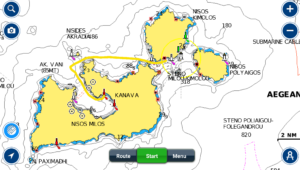
On Monday the forecast light winds showed up. After sailing well enough briefly upwind we cracked off and slowed down. Gybing downwind to our destination was not in the cards as the wind went very light and the swells had the boom swinging over the cockpit so we motored to the marina. The boats coming the other direction had double reefs in and sure enough as we prepared to med moor the wind built to 20 knots. We circled for a long time while a bunch of boats left; we watched one of them struggle for the better part of an hour getting their anchor free from something they had caught. We med moored and tied up up without much excitement, had lunch and waited to catch the lines for the other boats.
Tuesday: Milos Lay Day
Milos was absolutely the highlight of the trip. Early in our travels we had talking with some Aussies who said that their boat trip around Milos was the highlight of their time in the Greek islands. The waterfront in town was strewn with charter boats and people selling charter boat trips. After consulting the cruising guide we determined that we’d need “local knowledge” to get into the places that we wanted to see on our way around the island. After unsuccessfully trying to recruit a local Captain for the day we bit the bullet and negotiated ourselves a deal on a local charter boat for Tuesday.
This turned out to be an excellent decision. It would have been very difficult to get our charter boat into the first stop (the mooring lines for local captains were underwater and had to be dove for) and getting to the second and best stop would surely have sunk our tiny dinghies.
If we had another day to spend in Milos and light winds or northerlies we probably would have moved our boats to Kleftiko Beach and stern tied among the cliffs and caves. Our charts were useless for this area but the visual navigation would have been easy enough and there were plenty of great places to spend a day and explore on foot and by dinghy.
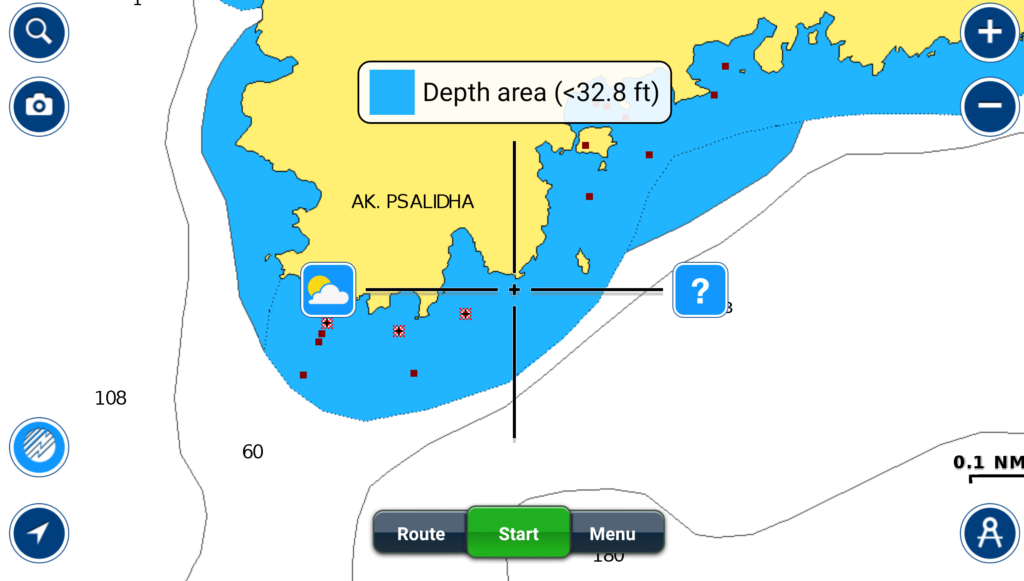
If you go ashore bring shoes as the rocks cut the feet of some crew who were barefoot.
Wednesday: Adhamas, Milos to Vathi, Sifnos
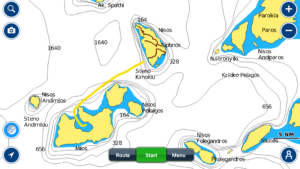
The first bit of our Wednesday sail we retraced the first bit of the prior day’s charter within a charter. My crew who hasn’t seen those sights appreciated the mini tour.
Then we motored for an hour or two and entertained ourselves with halyard swings and lunch. We sailed the last hour into Vathi in a nice breeze that I attribute to our proximity to the island.
Vathi was absolutely our most picturesque anchorage. A narrow pass opened up into a beach strewn cove surrounded by hills. Anchoring was easy and we could swim ashore or take the dinghy. The town or led right into the beach and was very picturesque.
Thursday: Vathi, Sifnos to Kamares, Sifnos
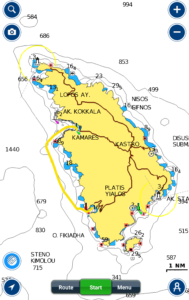
We slept in this morning at Vathi, went ashore for a stroll and went for a swim in the morning. But the call of the next port had my crew ready to go once everyone was up so we headed off for Kamares. Given the wind in the bay we expected no wind and an hour of motoring to Kamares and we were not disappointed when we got out there.
The cruising guide we said we could tie up on the inside of the pier/breakwater of the town along with the waterfront just inland of the breakwater. But when we arrived there were buoys setup to block mooring along waterfront and some ferries were using the inside of the pier/breakwater on the inside as well as the outside. We anchored right off the beach at the innermost part of the harbor and enjoyed the scenery.
The town of Kamares was nice but the real draw, as we had been told at prior stops, was the town of Castro which was accessible by taxi and bus from Kamares. Unlike Vathi, Kamares had some nightlife that we took advantage of even though we headed back to the boat early because we knew we had an early start the next morning.
Friday: Kamares, Sifnos to Parikia, Paros
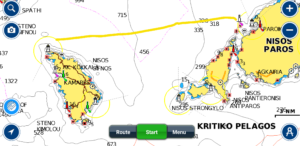
The last day we had our big sail back to Paros. The wind had returned and it was blowing about 20 out of the north as is it’s custom this time of year so we had a nice close reach east. We left early to get around the Northern tip of Sifnos before the wind and seas really had a chance to build in the morning and had a smooth sail back. Instead of feeling ill during this sail the crew, worn out from the week and accustomed to the motion of the boat slept through most of the passage and enjoyed parts of the sail back they were awake for. Med mooring was more chaotic in Paros than it was in Milos but it went fine nonetheless.
That day we spent some time in the northern bay on Paros around Naousa. As this was the closest we got to Mikonos this charter we felt it was appropriate to spend some time at a beach club: lounging in the surf, drink in hand with loud electronic music playing ashore. It was a very pleasant last night aboard.
Additional Tips
Bring your own Toilet Paper
Just because you’re paying to stay at a marina in Greece don’t expect the marina facilities you’re used to. The bathrooms, when they existed, were little more than port-a-poties with rimming water. We didn’t come across any marina showers. One marina only turned on the water for a few hours in the evening; this made sense when on our last day in Milos the entire island ran out of water!
Double Check Your Check-in
One of the boats in our group was assured their water tanks were full and the gauge was broken. But the guage was working and they only had ¼ tank of water.
We were assured that we didn’t need to turn on our battery charger to charge our battery using shore power.
As I mentioned above my boat was taking on water when it was heeled over.
Basically double check anything that seems suspicious. And triple check again.
“Cruising Guide” and Chartplotter
Navigation in the Cyclades is best done visually in good daylight. The convention is that the chartplotter was down below instead of in the cockpit; ours worked most of the time but was black and white with difficult to understand
Basically bring a smartphone to serve as a modern chartplotter.
The “cruising guide” that we bought ahead of time and was provided with our boat was a Greek waters coast pilot. It rarely had more than a short paragraph on what is worth doing ashore. Plan to do research about what to do ashore ahead of time or online after you arrive. We should have bought or downloaded a normal tourist guidebook (affiliate link); I recommend you learn from our mistake.
The early boat gets the good spot
My crew preferred to get to the next port as early as we could so that we had more time to explore our home for the day. I’m not normally one to rush but this strategy had us arriving at port as many boats were just getting underway for the day. This meant we had our choice of places to anchor or med moor. If you’re worried about med mooring I suggest you arrive early; as the day goes on the med mooring becomes more crowded and trickier. This might not be a concern outside of high season.
Swimming & Snorkeling
A handful of our crew brought their own snorkeling gear: mask, snorkel and fins. After the trip most who brought that gear said they should have left it at home. There just wasn’t much to see on the bottom and the sea caves we swam in were easy to explore with just a swimsuit (though from the dinghy was best).
Everyone who brought water shoes for exploring the land they swam to said they were definitely worth bringing.
Last Updated 30-Nov-2019
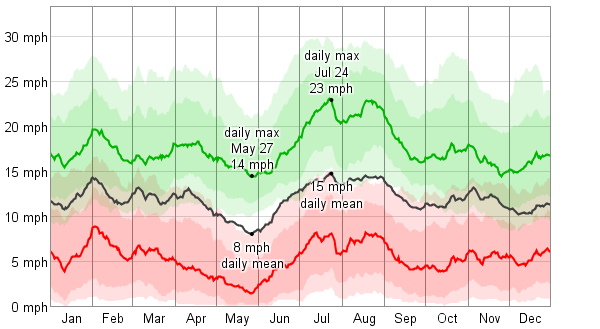
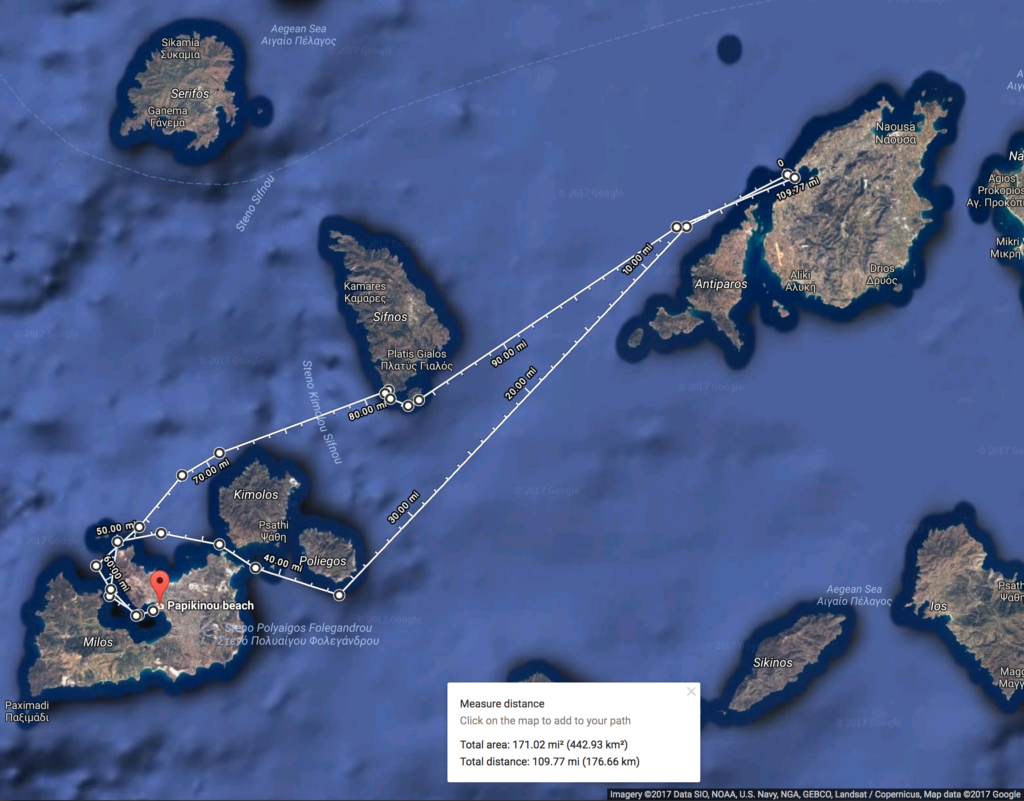
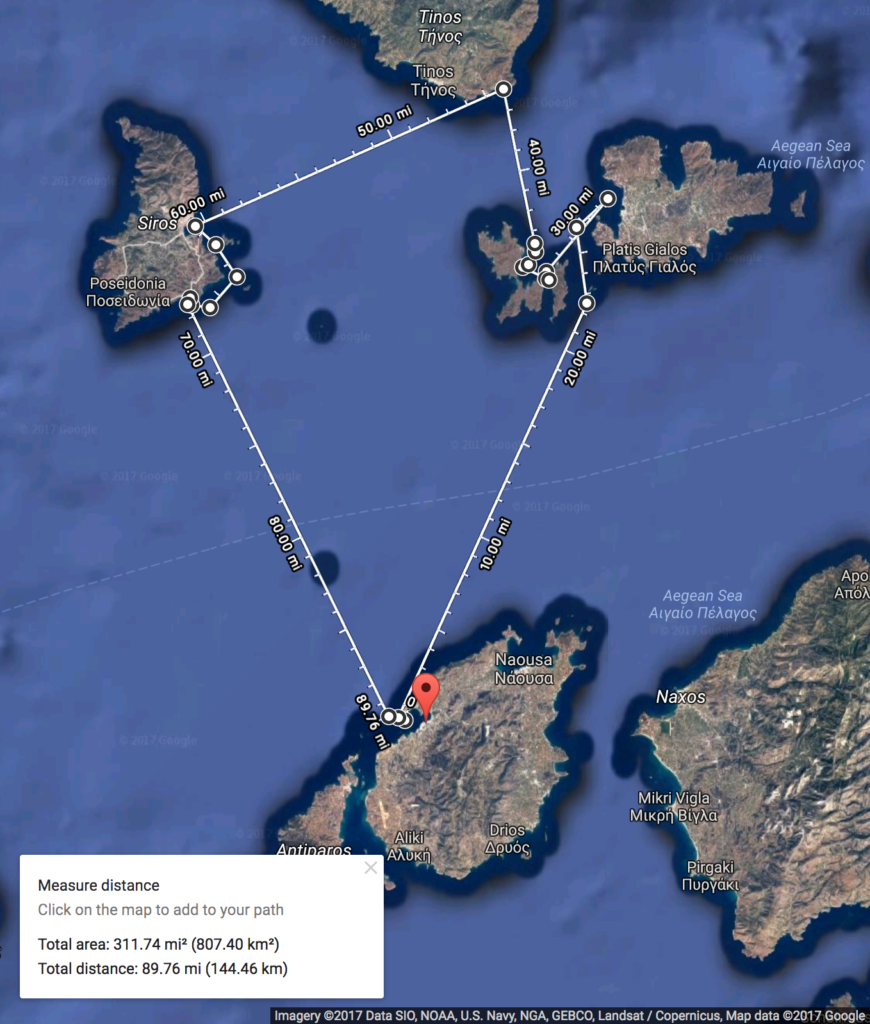
Reading about poorly prepared charter boats makes me wonder whether the good old Sunsail would be a better option. I tend to charter them most of the time due to the two reasons:
1) You know what you are going to get. The boat condition will not be perfect, but not horrible either;
2) They provide good discounts (sometimes very substantial) for repeating charterers;
Also what are your thoughts on getting catamaran vs mono in Aegian? We usually charter cats in Carribean (also did in Adriatic), however if part of the trip would be pointing into the wind, perhaps mono would be a better option.
I definitely go with sunsail where I can but for Greece the additional sailing distance made me break that rule.
I’ve chartered cats and monohulls. I think the deciding factor for me was med mooring – you could always squeeze in a monohull but finding room for a cat would have been tough.